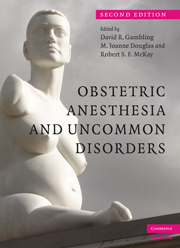Book contents
- Frontmatter
- Contents
- List of plates
- List of contributors
- Preface
- Section 1 Cardiovascular and respiratory disorders
- Section 2 Musculoskeletal disorders
- Section 3 Nervous system disorders
- Section 4 Metabolic disorders
- Section 5 Other disorders
- 17 Blood disorders
- 18 Infectious diseases in pregnancy
- 19 Dermatoses
- 20 Psychiatric disorders in pregnancy
- 21 Malignancy and pregnancy
- 22 Pregnancy and transplantation
- 23 Autoimmune diseases
- Index
- Plate Section
- References
17 - Blood disorders
from Section 5 - Other disorders
Published online by Cambridge University Press: 19 October 2009
- Frontmatter
- Contents
- List of plates
- List of contributors
- Preface
- Section 1 Cardiovascular and respiratory disorders
- Section 2 Musculoskeletal disorders
- Section 3 Nervous system disorders
- Section 4 Metabolic disorders
- Section 5 Other disorders
- 17 Blood disorders
- 18 Infectious diseases in pregnancy
- 19 Dermatoses
- 20 Psychiatric disorders in pregnancy
- 21 Malignancy and pregnancy
- 22 Pregnancy and transplantation
- 23 Autoimmune diseases
- Index
- Plate Section
- References
Summary
Background
Normal hematological indices during pregnancy
Multiple changes occur to the hematological system during pregnancy as outlined in Table 17.1. It is essential that the clinician be familiar with these in order to determine what is normal and what is abnormal when reviewing laboratory results in the pregnant woman.
Hematological testing during pregnancy
A routine, complete blood count during early pregnancy (first trimester) is important to identify common, preexisting hematological disorders that may impact on the pregnancy. In the uncomplicated pregnancy, a repeat blood count in the third trimester is done to assess the hematocrit in preparation for delivery.
Coagulation screening is performed only:
to investigate a significant bleeding history
to follow factor levels in patients with established disorders
during acute peripartum complications such as preeclampsia, massive hemorrhage or disseminated intravascular coagulation (DIC)
to monitor anticoagulation therapy.
Screening assays include platelets, prothrombin time (PT), activated partial thromboplastin time (aPTT), and fibrinogen (see Table 17.2). The subjective nature of the bleeding time as a measure of platelet function and its established lack of sensitivity and specificity as a predictor of clinical bleeding, has precluded its usefulness.
Currently, several centers use thromboelastography (TEG) to detect the risk of clinical bleeding; however, the sensitivity and specificity of this test remain unproven. Another point of care instrument, the platelet function analyzer (PFA-100®), is thought to represent an “in vitro” bleeding time.
- Type
- Chapter
- Information
- Obstetric Anesthesia and Uncommon Disorders , pp. 293 - 320Publisher: Cambridge University PressPrint publication year: 2008
References
- 1
- Cited by



